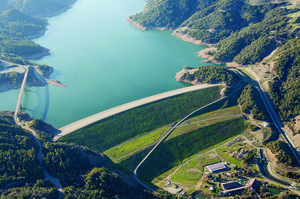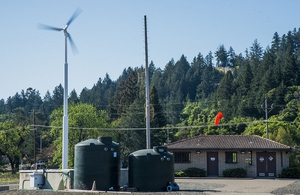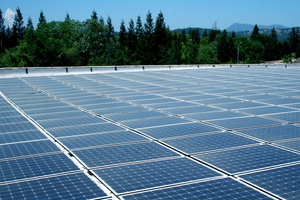The Day of the Lesson:
- Organize your students into pairs to work together during the lesson.
- The Sonoma Water educator will arrive at your classroom 20 minutes early to set up materials.
- If possible, we would like to use your computer to share a Google Slides presentation that we will send ahead of the class visit.
- Have your students clear everything off their desks before the lesson begins.
- This lesson requires the use of electrical outlets, please make available two to three during the lesson.
- Please do not leave your classroom while the Sonoma Water educator is teaching.
Asynchronous Lesson Series: Where does our electricity come from?
This 5 lesson asynchronous series will give your students the background information about the energy sources needed to generate our electricity, and the connection to global warming. These links are to interactive Google Slide presentations that, when opened, will ask you to make a copy which you can save to your Google Classroom and adapt them as needed for your students.
Lesson 1-What is renewable energy?
Lesson 2-What is nonrenewable energy?
Lesson 3-How is electricity made or generated?
Suggested YouTube Videos:
What are greenhouse gases? (2:29)
Climate change explained in 5 minutes-CBC Kids News (4:46)
Formation of Fossil Fuels (2:25)
Renewable Energy (3:16)
Solar Power (3:00)
Suggested Curriculum:
National Energy Education Development Project (NEED)
Vermont Energy Education Program (VEEP)
National Renewal Energy Lab Education Resources (NREL)
Suggested Vocabulary:
Biomass Energy: Comes from anything that is alive such as trees, crops, garbage, and animal waste, and can be converted to heat to produce electricity.
Carbon Dioxide: A colorless, odorless noncombustible gas with the formula CO2 that is present in the atmosphere. It is formed by the combustion of carbon and carbon compounds (such as fossil fuels and biomass) and by respiration, which is a slow combustion in animals and plants, and by the gradual oxidation of organic matter in the soil.
Clean Energy: Also known as renewable energy which does not emit carbon dioxide.
Climate Change: Is when there is a big difference in normal climate patterns over a long time (30 years or more).
Coal: Is a sedimentary rock formed hundreds of millions of years ago when plants died, were buried, and under heat and pressure changed into coal. Today, coal is burned to produce electricity.
Energy Transfer: Energy is never created; it is transferred from one object to another.
Fossil Fuel: Fuels (coal, oil, natural gas, etc.) that result from the compression of ancient plant and animal life formed over millions of years.
Geothermal Energy: The heat energy that is produced by natural processes inside the earth. It can be taken from hot springs, reservoirs of hot water deep below the ground, or by breaking open the rock itself.
Greenhouse Gases: Gases that trap the heat of the sun in the Earth's atmosphere, producing the greenhouse effect. The two major greenhouse gases are water vapor and carbon dioxide. Lesser greenhouse gases include methane, ozone, chlorofluorocarbons, and nitrogen oxides.
Hydropower: Energy that comes from moving water.
Nonrenewable: Fuels that cannot be easily made or "renewed." We can use up nonrenewable fuels. Oil, natural gas, and coal are nonrenewable fuels.
Nuclear Energy: Energy that comes from splitting atoms of radioactive materials, such as uranium.
Natural Gas: Is a mixture of gases you can't see, smell, or taste that is found underground and can be burned to make heat used to produce electricity.
Renewable: Fuels that can be easily made or "renewed." We can never use up renewable fuels. Types of renewable fuels are hydropower (water), solar, wind, geothermal, and biomass.
Solar Panels: Devices that convert the sun’s energy into electricity.
Definitions adapted from: https://www.eia.gov/kids/
Water and Energy Education programs are FREE thanks to funding from these partners:




